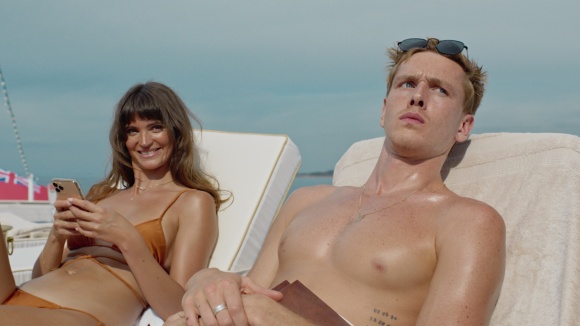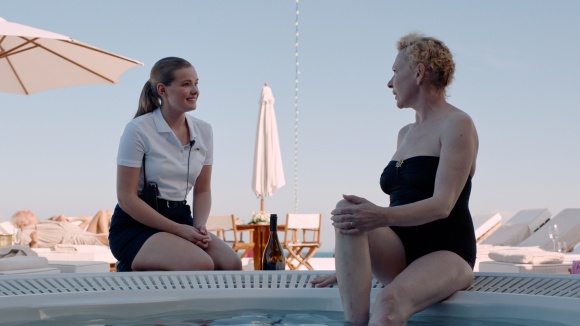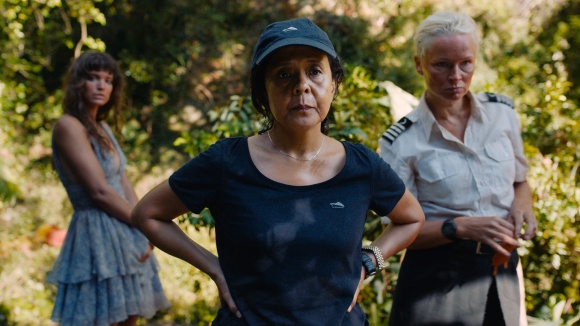Es gibt mehrere Gründe, weshalb »Triangle of Sadness« im Gedächtnis bleiben wird. Einer davon ist ein sehr trauriger: Darstellerin Charlbi Dean starb am 29. August im Alter von nur 32 Jahren. Die als Model bekannt gewordene Südafrikanerin hat in Östlunds Film ihre erste und nun auch letzte Kinohauptrolle. Als Influencerin Yaya hinterlässt sie einen bleibenden Eindruck in diesem an einprägsamen Figuren nicht armen Film. Ihr Partner: Harris Dickinson als Carl, männliches Model und ebenfalls erfolgreich – allerdings bereits auf dem absteigenden Ast, wie wir im Prolog des Films erahnen können. So muss er bei einem Casting gleich zwei Mal einen »Walk« machen, außerdem sei sein »Triangle of Sadness« zu deutlich – eine schöne Bezeichnung für jene Zone auf der Stirn, wo sich Sorgen- und Zornesfalte treffen. Nebenbei erläutert der Prolog den Unterschied zwischen »happy« und »grumpy« Labels (H&M/Balenciaga) und taucht tief hinein in eine Welt, in der gutes Aussehen die Währung ist, Oberfläche alles, was zählt, und in der jede Überzeugung genauso austauschbar ist wie die Slogans, die bei einer Fashion Show über die Leinwand wabern: »Stop Climate Change«, »All are equal«. Das passende Urteil zur eigenen Haltung liefert dieselbe Show gleich mit: »Cynicism masquerading as Optimism«.
© Fredrik Wenzel/Alamode Film
Dem Prolog folgen drei recht unterschiedlich gelagerte Kapitel. Im ersten erleben Yaya und Carl eine kleine Beziehungskrise, ausgelöst durch die Frage, wer im Nobelrestaurant an diesem Abend die Rechnung übernimmt. Mit doppelbödigen Dialogen widmet sich Östlund einem seiner Lieblingsthemen: Geschlechterrollen und männliche Orientierungslosigkeit angesichts ihres Wandels. Das zweite Kapitel begleitet Yaya und Carl auf eine Luxusjacht, auf der sich ausschließlich die sehr Reichen und sehr Schönen tummeln, vom einsamen skandinavischen IT-Milliardär (Henrik Dorsin) über den klischeehaft protzenden russischen Oligarchen Dimitry (Zlatko Buric) mit gelangweilter, spleeniger Gattin Vera (Sunnyi Melles) bis hin zu einer älteren Deutschen (Iris Berben), deren Sprache nach einem Schlaganfall auf die kryptischen Worte »In den Wolken!« reduziert ist. Die nettesten Gäste an Bord sind ein sehr britisches altes Ehepaar, das ein Vermögen mit Handgranaten und Landminen gemacht hat. Der Kapitän (wunderbar: Woody Harrelson), Säufer, Idealist und Sozialist, hat sich derweil mit sehr viel Alkohol in seiner Kabine verkrochen, wird sich aber zu einem späteren Zeitpunkt ein in mehrfacher Hinsicht hochprozentiges Zitateduell mit Dimitry zum Thema Sozialismus versus Kapitalismus liefern.
Der Ton des Films wird noch schärfer, wenn Östlund uns in episodischem Wahnsinn die Obszönität des Reichtums und der Machtverhältnisse an Bord vor Augen führt. So werden per Hubschrauber ein paar Gläser Nutella zur Jacht geflogen, weil ein Gast sich das gewünscht hat, und die gesamte Crew des Schiffs muss irgendwann eine Runde im Meer baden gehen, nur weil Vera der festen Überzeugung ist, ihnen damit etwas Gutes zu tun. Widerspruch wird nicht geduldet. Und die Bediensteten? Lächeln zu jeder noch so unsinnigen Frage und zu jeder noch so miesen Beleidigung. Was bleibt ihnen anderes übrig?
© Fredrik Wenzel/Alamode Film
Diesen mit Gusto ausgemalten Mikrokosmos des Narrenschiffs, das natürlich auch ein Spiegel unserer spätkapitalistischen Gesellschaften ist, lässt Östlund schließlich in einem beispiellosen Exzess implodieren. Das noble Captain's Dinner verwandelt sich im Sturm in eine Kotzorgie. Auch diese Szene zählt zu den Aspekten des Films, die zweifellos haften bleiben, weil sie so bewusst jede Geschmacksgrenze überschreitet. Neben Östlunds Lust an der Provokation lässt sich daraus aber auch ein authentischer Ausdruck der Wut angesichts all des Unrechts und Bullsh*ts dieser Welt lesen. Und darum ist es eine Sequenz, die zugleich Ekel und Vergnügen hervorruft (oder zumindest hervorrufen kann). Und es ist nicht das Ende der Turbulenzen. Auf einer einsamen Insel (Kapitel 3) finden sich einige Überlebende wieder – und erleben nun die Umkehrung der Hierarchie . . .
Die satirische Schlagkraft von »Triangle of Sadness« hätte möglicherweise von thematischer Reduktion profitiert – musste sowohl die Modebranche als auch die Welt der Superreichen beschossen werden? –, ebenso wie von ein paar Straffungen, denn die jetzigen 142 Minuten vermögen nicht durchweg zu fesseln. Und keine Frage: Östlund war schon subtiler. Im Vergleich zu »Höhere Gewalt« und »The Square« ist »Triangle of Sadness« brachial, die Pointen fallen simpler und härter aus. Aber ist diese Form der Überspitzung nicht angemessen, ja vielleicht sogar notwendig angesichts von Verhältnissen, an die wir uns so sehr gewöhnt haben, dass uns ihre Obszönität meist schon gar nicht mehr auffällt?
© Fredrik Wenzel/Alamode Film
Der Film erschöpft sich zudem nicht im billigen Reichen-Bashing. Vielmehr zeigt er, dass es genau jene Verhältnisse sind, die das Verhalten der Menschen prägen, und dass Unterprivilegierte, kommen sie in eine Machtposition, nicht zwangsläufig besser sind. Östlunds Blick ist völlig illusionslos, doch trotz seiner (im klassischen Sinne) zynischen Perspektive: Ganz herzlos ist er nicht. Er lässt alle seine Figuren in ihrer Menschlichkeit und Widersprüchlichkeit zur Geltung kommen, beispielsweise auch Dimitry, der anfangs wie eine fiese Karikatur erscheint. Darin liegt wohl auch die Melancholie, die in »Triangle of Sadness« immer wieder mitschwingt.


